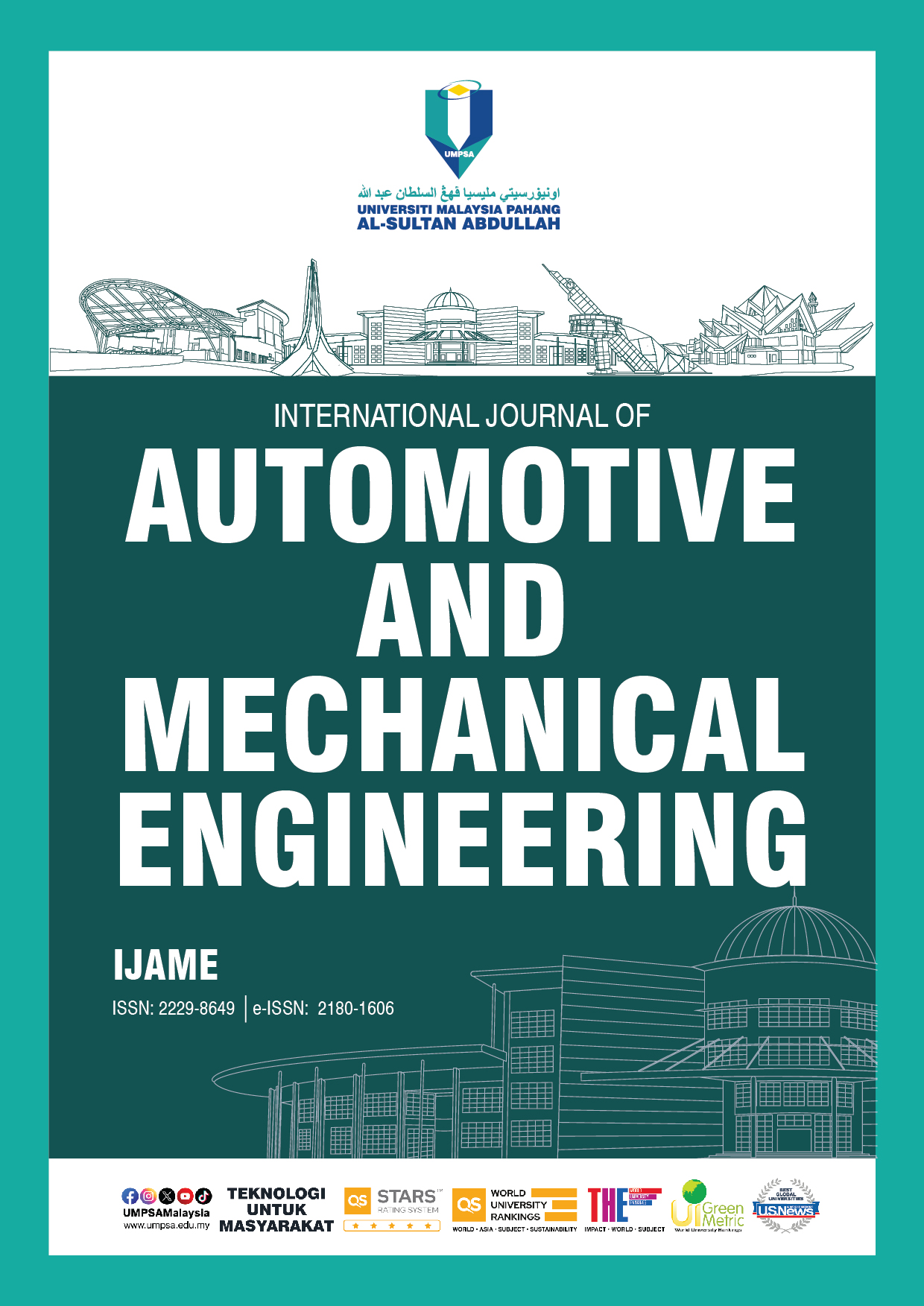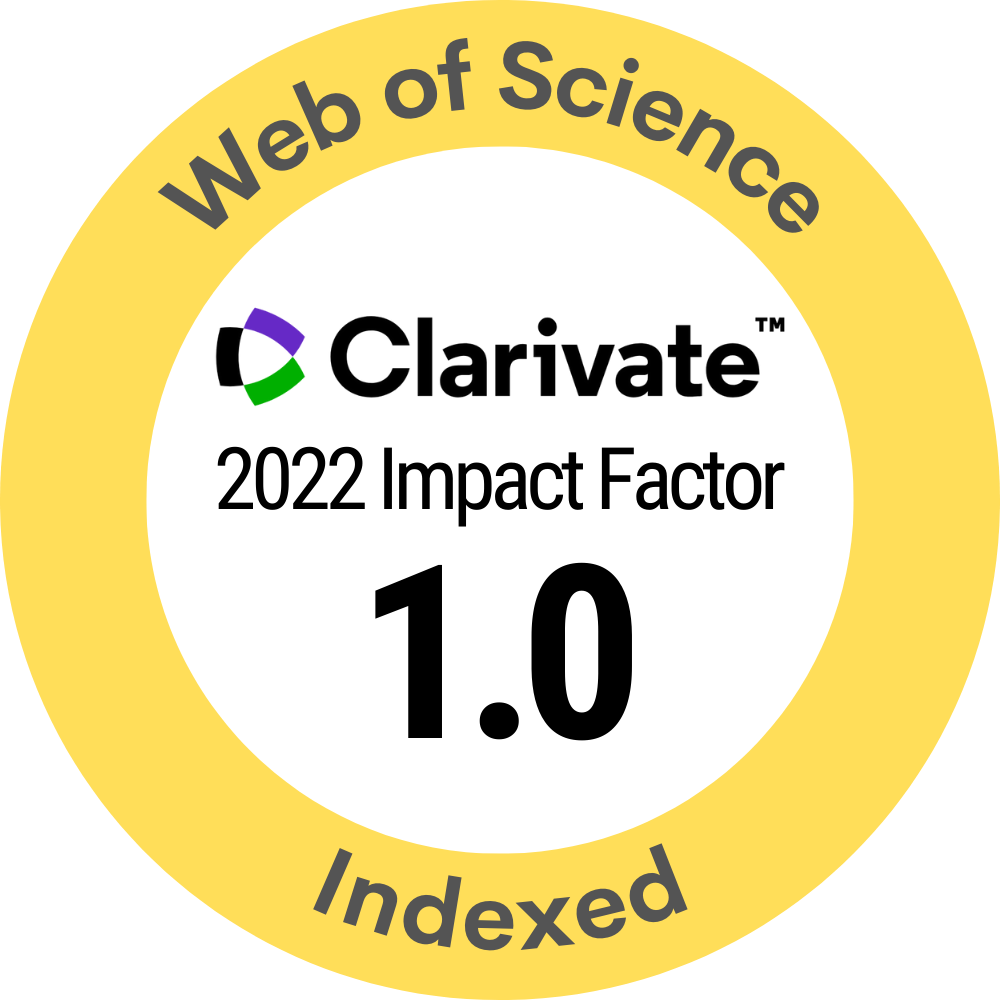Modeling and Contact Stress Analysis of Crossed-Axes Helical Gear System
DOI:
https://doi.org/10.15282/ijame.22.2.2025.15.0952Keywords:
Helical gear, Crossed-axes helical gear, Tip relief , Epicycloid, Contact stress, Tooth root stressAbstract
Crossed helical gears are susceptible to pitting damage resulting from contact stress, primarily due to the theoretical point contact between the gears. The contact point transforms into an ellipse due to the deformation of the elastic material under varying loading conditions. The overheating between the tooth profiles during the engagement process contributes to the proliferation of pits, deteriorating the tooth surface and causing premature tooth failure. This study investigates the influence of two modifications: the tip relief design, and the compound profile design, which combines involute and epicycloid profiles. A shaping process generates both standard and modified helical gears. The results indicate that increasing the amount of misalignment with a smaller harmonic waveform reduces the transmission error. The involute-epicycloid profile reduces the sliding velocity with the most significant improvement of approximately 16%. A decrease in the angle of pressure and an increase in the helix angle of 1.5 and 1.7, respectively, enhance the total contact ratio. The maximum contact stress observed for the modified involute-epicycloid surface decreased by 6%, 6%, and 2%, while the tooth root stress reduced by 6%, 8%, and 12% for the three positions, respectively. Meanwhile, the maximum contact stress for tip relief modification decreased by 2%, 6%, and -6%, whereas the tooth root stress reduced by 2%, 7%, and -1% for the three positions, respectively. Consequently, the modified crossed helical gear drive demonstrates superior performance compared to the standard gear drive for a given helix angle. Furthermore, the stress concentration factor decreased through the use of the modified helical teeth by about 2% and 6%.
References
[1] J. J. Uicker Jr, G. R. Pennock, and J. E. Shigley, Theory of machines and mechanisms, 6th ed., Cambridge University Press, 2023.
[2] W. A. Altabey, Fundamentals of Machine Component Design, 4th ed., Elsevier, 2023.
[3] S. S. Rattan, Theory of machines, 4th ed., Tata McGraw-Hill Education, 2014.
[4] S. Sankar and M. Nataraj, “Prevention of helical gear tooth damage in wind turbine generator: a case study,” Proceedings of the Institution of Mechanical Engineers, Journal of Power and Energy, vol. 224, no. 8, pp. 1117-1125, 2010.
[5] N. Seyama, K. Nagamura, and K. Ikejo, “Design of Involute-Cycloid Composite Tooth Profile Spur Gear to Reduce the Influence of Center Distance Error on Driving Performance,” Dept. of Mechanical System Engineering, Graduate School of Hiroshima University, Kagamiyama 1-4-1, Higashi-Hiroshima, Hiroshima, pp. 739-8527, Japan, 2011.
[6] X. Zhang and Z. Liang, “Comparison of conventional double-helical and curvilinear cylindrical gear drives in terms of transmission errors and stress,” Transactions of FAMENA, vol. 45, no. 3, pp. 1-18, 2021.
[7] D. Liang, S. Meng, and R. Tan, “Mathematical model and characteristics analysis of crossed-axis helical gear drive with small angle based on curve contact element,” Science Progress, vol. 104, no. 2, pp. 1-19, 2021.
[8] J. Wu, P. Wei, C. Zhu, P. Zhang, and H. Liu, “Development and application of high strength gears,” The International Journal of Advanced Manufacturing Technology, vol. 132, no. 7, pp. 3123-3148, 2024.
[9] M. Abdulaal and M. Q. Abdulah, “Mathematical model and generation analysis for crossed helical gear system,” World Journal of Engineering, 2024.
[10] M. Q. Abdullah and M. A. Kadum, “Stress concentration factor analysis of helical gear drives with asymmetric teeth profiles,” Journal of Engineering, vol. 24, no. 5, pp. 14-28, 2018.
[11] M. A. Kadhim and M. Q. Abdullah, “Generation and stress analysis of helical gear tooth combining involute with epicycloidal and hypocycloidal profiles,” International Journal of Automotive and Mechanical Engineering, vol. 22, no. 1, pp. 12016-12034, 2025.
[12] X. Zheng, W. Zhu, G. Li, and Y. Hu, “Reshaping load-dependent mesh excitation waveforms of spur gears—an analytical framework on tip relief modeling and design,” Machines, vol. 13, no. 2, p. 161, 2025.
[13] C. Liu, K. Ouyang, T. Jiang, and C. Liu, “Fracture failure analysis of gear teeth,” Journal of Physics: Conference Series, International Conference on Applied Mechanics and Structural Materials, Nanjing, vol. 2206, no. 1, p. 012036, 2021.
[14] A. Jung, Machine Learning: The Basics, Springer Singapore, 1st ed., 2022.
[15] R. R. Craig and E. M. Taleff, Mechanics of Materials, 4th ed. New York: John Wiley and Sons, 2020.
[16] K. H. Grote and H. Hefazi, Springer Handbook of Mechanical Engineering, 2nd ed., Springer Singapore, 2021.
[17] D. T. Babichev and N. A. Barmina, “Computer-aided design of gears and machine-tool meshing with application of new concepts, images and indices,” New Approaches to Gear Design and Production, pp. 157-185, 2020.
[18] F. L. Litvin, Q. Fan, D. Vecchiato, A. Demenego, R. F. Handschuh, and T. M. Sep, “Computerized generation and simulation of meshing of modified spur and helical gears manufactured by shaving,” Computer Methods in Applied Mechanics and Engineering, vol. 190, no. 39, pp. 5037-5055, 2001.
[19] Z.-G. Wang, Y.-C. Chen, “Design of a helical gear set with adequate linear tip-relief leading to improved static and dynamic characteristics,” Mechanism and Machine Theory, vol. 147, p. 103742, 2020.
[20] Fuentes-Aznar, S. E. Gonzalez-Perez, “Computerized Simulation of Manufacturing Errors in Cylindrical Spur Gears and Their Compensation Through Flank Modifications Mechanisms and Machine Science,” In: Goldfarb, V., Trubachev, E., Barmina, N. (eds) Advanced Gear Engineering., vol 51. Springer, pp. 1-25, 2018.
[21] X. Xu, Y. L. S. Zuo, P. Tenberge, P. Dong, Y. Liu et al., “A novel tooth tip relief method for reducing micro-pitting of spur gears,” Advances in Mechanical Engineering, vol. 13, no. 9, 2021.
[22] M. Temirkhan, H. B. Tariq, K. Kaloudis, C. Kalligeros, V. Spitas, and C. Spitas, “Parametric quasi-static study of the effect of misalignments on the path of contact, transmission error, and contact pressure of crowned spur and helical gear teeth using a novel rapidly convergent method,” Applied Sciences, vol. 12, no. 19, p. 10067, 2022.
[23] T. Stolarski, Y. Nakasone, and S. Yoshimoto, Engineering analysis with ANSYS software, 2nd ed., Butterworth-Heinemann: Springer, 2018.
[24] J. D. Smith, Gear noise and vibration, 2nd ed., Boca Raton: CRC Press, 2003.
[25] J. Denavit, R. S. Hartenberg, “A kinematic notation for lower-pair mechanisms based on matrices,” Applied Mechanics, vol. 22, no. 2, pp. 215-221, 1955.
[26] S. Luo, M. Jingyu, “Manufacturing and contact characteristics analysis of a novel 2K-H internal meshing planetary reducer with involute-cycloid combined tooth profiles,” Mechanical Engineering Science, vol. 238, no. 13, pp. 6706-6724, 2024.
[27] N. Seyama, K. Nagamura, K. Ikejo, and K. Isaki, “GSD-05 Influence of design parameters on strength and driving performance of involute-cycloid composite tooth profile gears (gear strength and durability, including gear materials and heat treatment techniques),” in The Proceedings of the JSME International Conference on Motion and Power Transmissions 2009, The Japan Society of Mechanical Engineers Pages: 329-332, 2009.
[28] S. P. Radzevich, M. Storchak, Advances in gear theory and gear cutting tool design, 1st ed., Switzerland: Springer Cham, 2022.
[29] S. Glodež, Gear geometry, Elsevier, pp. 59-92, 2025.
[30] V. Abadjiev, E. Abadjieva, “Geometric Pitch Configurations–Basic Primitives of the Mathematical Models for the Synthesis of Hyperboloid Gear Drives.,” In: Goldfarb, V., Trubachev, E., Barmina, N. (eds) Advanced Gear Engineering. Mechanisms and Machine Science, vol 51. Springer, Cham., 2018.
[31] A. A. Shabana, “Analysis of involute-curve geometry using position gradients: Application to gear-tooth profile,” Mechanics Based Design of Structures and Machines, vol. 52, no. 12, pp. 10723-10745, 2024.
[32] R. C. Juvinall, K. M. Marshek, Fundamentals of machine component design, 5th ed., New York: John Wiley and Sons, 2020.
[33] H. A. Zschippang, S. Weikert, K. Wegener, “Face-gear drive: Meshing efficiency assessment,” Mechanism and Machine Theory, vol. 171, p. 104765, 2022.
[34] A. L. Kapelevich, Direct gear design, 2nd ed., Boca Raton: CRC Press, 2021.
[35] E. K. Browning, M. A. Zupan, Microeconomics: Theory and applications, 13th ed., New York: John Wiley and Sons, 2020.
[36] L. Becker, P. Tenberge, “Crossed helical gears—simulative studies and experimental results on non-involute geometries,” Forschung im Ingenieurwesen, vol. 87, no. 3, pp. 949-959, 2023.
[37] O. D. Mohammed, “An analytical approach for the determination of helical gear tooth geometry,” Journal of Engineering, Design and Technology, vol. 22, no. 6, pp. 2020-2042, 2024.
[38] N. Gaoxiang, S. Chaosheng, F. Zifan, Z. Zhang, “Effects of geometric design parameters and misalignments on contact ellipse of crossed beveloid gears,” Mechanism and Machine Theory, vol. 165, no. 104441, pp. 1-20, 2021.
[39] Victor R. Casanova, I. G. Perez, “Investigation of the effect of contact pattern design on the mechanical and thermal behaviors of plastic‐steel helical gear drives,” Mechanism and Machine Theory, vol. 164, no. 104401, pp. 1-20, 2021.
[40] E. Tamuta, R. Nemoto, H. Tomita, E. Tanaka, H. Takahashi, “Contacting State on Imaginary Rack of Crossed Helical Gears,” in The 3rd International Conference on Design Engineering and Science, ICDES 2014, Pilsen, Czech Republic, August 31 – September 3, 2014, 2014.
[41] E. Tamura, R. Nemoto, N. Seyama, E. Tanaka, “Contact Stress State of Crossed Helical Gears,” in The 4th International Conference on Design Engineering and Science, ICDES 2017, Aachen, Germany, September 17-19, 2017.
[42] F. L. Litvin, I. G. Perez, A. Fuentes, D. Vecchiato, and T. M. Sep, “ Generalized concept of meshing and contact of involute crossed helical gears and its application,” Computer Methods in Applied Mechanics and Engineering, vol. 194, no. 34–35, p. 3710-3745, 2005.
[43] P. M. Ramachandra, S. Sutar, G. M. Kumara, “Stress analysis of a gear using photoelastic method and finite element method: Review,” Materials Today: Proceedings, vol. 65, no. 8, pp. 3820-3828, 2022.
Downloads
Published
Issue
Section
License
Copyright (c) 2025 The Author(s)

This work is licensed under a Creative Commons Attribution-NonCommercial 4.0 International License.







